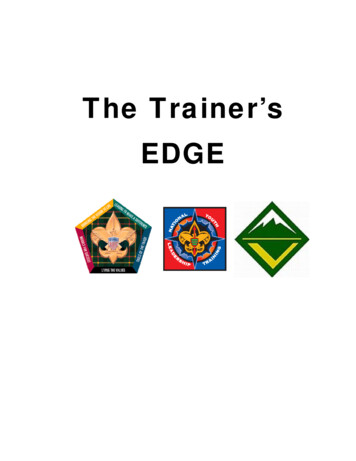Results Database Train -the-Trainer Workshop August 2021
Adverse Event Information: IntroductionResults Database Train-the-Trainer WorkshopAugust 2021
Results Information Submission42 CFR Part 11 – Subpart C§ 11.48 – What constitutes clinical trial results information?42 CFR 11.48(a) applies to applicable clinical trials required to register and with a PrimaryCompletion Date on or after January 18, 2017 (effective date).Results information consists of: Participant flowDemographic and baseline characteristicsOutcomes and statistical analysesAdverse event informationProtocol and statistical analysis planAdministrative informationAdditional clinical trial results information for applicable device clinical trials of unapproved or uncleareddevice products
What AreAdverse Events?“A table of anticipated and unanticipatedserious adverse events grouped by organsystem, with number and frequency of suchevent in each arm of the clinical trial.”From: FDAAA 801, Sec. 282(j)(3)(I)(iii)(I)
What AreAdverse Events?“A table of anticipated and unanticipatedadverse events that are not included in the[Serious Adverse Events] table . . . that exceed afrequency of 5 percent within any arm of theclinical trial, grouped by organ system, withnumber and frequency of such event in eacharm of the clinical trial.”From: FDAAA 801, Sec. 282(j)(3)(I)(iii)(II)
Adverse Event Data Tables42 CFR 11.48(a)(4)Information for completing three tables summarizing anticipated and unanticipatedadverse events collected by arm or comparison group1) All serious adverse events2) Adverse events, other than serious adverse events, that exceed a frequency of5 percent within any arm of the clinical trial3) All-cause mortality
What Is Included in Adverse Events?Methods for collecting adverse events Time Frame Adverse Event Reporting Description If adverse event information collected in the clinical trial is collected based on a different definition of“adverse event” and/or “serious adverse event” Can also be used to clarify the analysis population, if necessary Source Vocabulary Name for Table Default Standard terminology, controlled vocabulary, or classification and version from which adverse event terms aredrawn, if any Collection Approach for Table Default The type of approach taken to collect adverse event information, whether systematic or non-systematicResults from: NCT00137969
What Is Included in Adverse Events? For each of the three tables Adverse Event Arm/Group Information Arm/Group Title and Arm/Group Description Total number of participants affected andat risk, by arm/group For serious and other adverse events Descriptive term for the adverse event Organ system associated with the adverseevent Number of participants affected by eachadverse event Number of participants at risk for eachadverse event, if different from the totalResults from: NCT00137969
Similarities between Publications andClinicalTrials.govPublication (Table 2)ClinicalTrials.govAdapted from: Merrill JT, et al. Arthrit Rheum, 2010 and NCT00137969
Best PracticesReport summary data at the end ofthe study. Not real-time adverse eventreporting while the study isongoingReport Serious Adverse Events andOther (Not Including Serious)Adverse Events in separate tables.Report data in accordance with theprocedures for data collectiondescribed in the study protocol. Use the Adverse Event TermAdditional Description todescribe the methods, asneeded.
For serious and other adverse events Descriptive term for the adverse event Organ system associated with the adverse event Number of participants affected by each adverse event Number of participants at risk for each adverse event, if different from the total. Results from: NCT00137969. 42 CFR 11.48\ 愀尩\ 尩\
May 02, 2018 · D. Program Evaluation ͟The organization has provided a description of the framework for how each program will be evaluated. The framework should include all the elements below: ͟The evaluation methods are cost-effective for the organization ͟Quantitative and qualitative data is being collected (at Basics tier, data collection must have begun)
Silat is a combative art of self-defense and survival rooted from Matay archipelago. It was traced at thé early of Langkasuka Kingdom (2nd century CE) till thé reign of Melaka (Malaysia) Sultanate era (13th century). Silat has now evolved to become part of social culture and tradition with thé appearance of a fine physical and spiritual .
On an exceptional basis, Member States may request UNESCO to provide thé candidates with access to thé platform so they can complète thé form by themselves. Thèse requests must be addressed to esd rize unesco. or by 15 A ril 2021 UNESCO will provide thé nomineewith accessto thé platform via their émail address.
̶The leading indicator of employee engagement is based on the quality of the relationship between employee and supervisor Empower your managers! ̶Help them understand the impact on the organization ̶Share important changes, plan options, tasks, and deadlines ̶Provide key messages and talking points ̶Prepare them to answer employee questions
Dr. Sunita Bharatwal** Dr. Pawan Garga*** Abstract Customer satisfaction is derived from thè functionalities and values, a product or Service can provide. The current study aims to segregate thè dimensions of ordine Service quality and gather insights on its impact on web shopping. The trends of purchases have
Chính Văn.- Còn đức Thế tôn thì tuệ giác cực kỳ trong sạch 8: hiện hành bất nhị 9, đạt đến vô tướng 10, đứng vào chỗ đứng của các đức Thế tôn 11, thể hiện tính bình đẳng của các Ngài, đến chỗ không còn chướng ngại 12, giáo pháp không thể khuynh đảo, tâm thức không bị cản trở, cái được
First Aid and Choking Train-the-Trainer Requirements Wisconsin Community-Based Care and Treatment Training Registry Page 5 University of Wisconsin-Green Bay General Train-the-Trainer Program Requirements Applicants for Train-the-Trainer prog
The Trainer’s EDGE Purpose of the Course The Trainer’s EDGE replaces the Trainer Development Conference (BSA 500) as the required train‐the‐ trainer course for Wood Badge and NYLT staffs. The purpose of the Trainer’s EDGE course is to provide and help d























